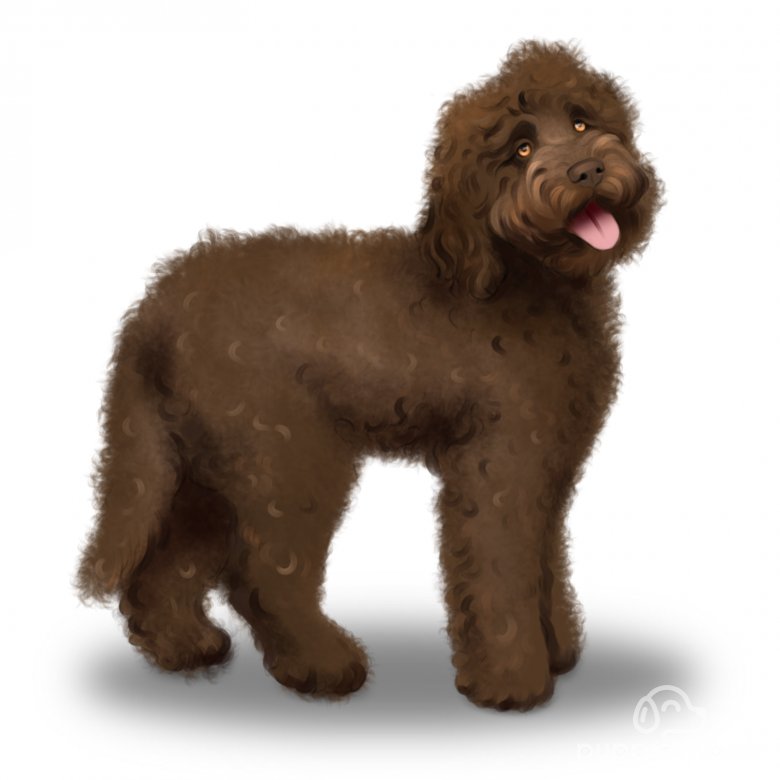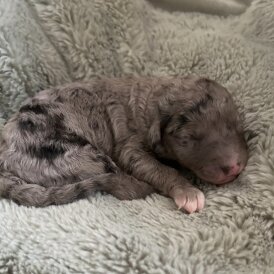When it comes to cuddly crossbreeds, Labradoodles are oodles of fun. They’re often referred to as designer dogs, and that’s unfortunate. Perhaps they’re better referred to as crossbreeds since they’ve been well-established in the UK and elsewhere for over half a century. Labradoodles come from down under, in Australia, and they’ve quickly become one of the most popular crossbreeds here in the UK as of late. Although Labradoodles have many wonderful qualities that make them an excellent choice of puppy, there are many considerations that prospective owners should take note of before purchasing one.
Why Labradoodles are Great
Some highlights of Labradoodles:
Affectionate: this breed is known for being loving and affectionate with owners and their families.
First-time owners: this breed is an ideal choice of puppy for first-time owners.
Playful: Labradoodles love to play as puppies and well into adulthood, making them a fun breed.
Popularity: Labradoodles are a popular breed in the UK and as such it isn’t difficult to find reliable information about them as well as knowledgeable veterinarians to care for them.
Intelligence: this breed is highly intelligent and as such can learn tricks and commands rather easily and without much difficulty or repetition.
Things to Consider when Looking at Labradoodles for Sale
Some downsides to the Labradoodle:
Recognition: Labradoodles are not a breed that is recognised by the Kennel Club of Great Britain, which makes them susceptible to unethical breeding practices.
Energetic: this breed is high-energy and requires plenty of attention in order to remain stimulated and to stave off naughty behaviour.
Health: since Labradoodles are a crossbreed, they can inherit many hereditary health issues from either or both parents.
Mischievous: Labradoodles are known for having a polarising temperament. Many can be well-behaved but many can also exhibit signs of stubbornness or behave mischievously at times.
History of the Labradoodle
As the name implies, the Labradoodle is a crossbreed between a Labrador Retriever and a Poodle (standard, miniature, or toy sizes). Either parent can be a Labrador Retriever or Poodle, or one or both parents can be Labradoodles. While most pedigree breeds have ancestry shrouded in mystery, crossbreeds such as the Labradoodle are more well-known. It’s debated, however, where the first Labradoodles appeared. Some argue that this breed was popularised on American television programmes in the 1950s and 1960s, others believe that Australian Wally Conron created the first Labradoodle in 1989. This latter claim is speculative and ample evidence shows that Labradoodles existed decades prior. Regardless, Guide Dogs Victoria was known to be the first organisation to breed Labradoodles.
Appearance
It’s difficult to define a general appearance for Labradoodles since they’re a crossbreed. Consequently, Labradoodle puppies can develop and grow to a wide variety of sizes and can come in many different colours. It’s worth noting that after four generations of breeding Labradoodles together, their appearance and temperament normalises and many more common features are observable. One of the advantages of Labradoodles is that they’re available in so many diverse shapes and colours, but on the other hand, a lack of recognition by the Kennel Club of Great Britain and most kennel clubs worldwide results in a lack of understanding their undesirable traits and features.
How big is the Labradoodle?
Labradoodles are small/large-sized dogs. Males and females alike grow on average between 30-71 cm in height. They tend to come in three sizes, which explains the wide variance in heights.
How heavy is a Labradoodle?
Fully-grown adult male and female Labradoodles weigh between 10-40 kg on average. Since they come in three sizes, Labradoodles vary widely in their weight.
What colour is the Labradoodle?
There are no kennel club guidelines stating acceptable colours for Labradoodles, but they tend to come in the following colours:
Chocolate;
Cafe;
Parchment;
Cream;
Gold;
Apricot;
Red;
Black;
Silver;
Chalk;
Lavender;
Blue.
As a rule of thumb, Labradoodles can inherit any coat colour that a Poodle can have.
Temperament
As with appearances, Labradoodles also tend to vary significantly in their temperament due to being a crossbreed. Labradoodles bred for four generations or more tend to be more consistent. Some commonalities can be seen, however. Since Labradoodles are bred from Poodles, a highly intelligent breed, Labradoodles are amongst the most intelligent breeds. They also tend to be affectionate and loyal companions. There are many qualities such as this that make them an ideal puppy choice for first-time owners.
Do Labradoodles make good guard dogs?
This breed isn’t the best choice for a watchdog or guard dog, but they will alert owners to suspicious activity around the home by barking.
Do Labradoodles bark a lot?
Some Labradoodles may bark compulsively if they haven’t been well-trained. Proper training can ensure that they keep barking under control and to only bark when necessary.
Are Labradoodles easy to train?
Since Labradoodles are intelligent, they can be easy to train. They should be trained obedience and with sensitivity and patience, especially as puppies. This breed may show signs of mischief or stubbornness, so ensure that they understand their role and are taught obedience as puppies.
Are Labradoodles playful?
Both as puppies and as adults, Labradoodles are very playful. They’ll enjoy plenty of playtime indoors and outdoors, so endeavour to provide them with a home where they can remain active.
Are Labradoodles good with children?
Labradoodles are amongst the most cuddly and affectionate breeds around children. They are an excellent family companion that will enjoy plenty of playtime with children of all ages.
Are Labradoodles good with other pets?
They may be large, but Labradoodles tend to get along very well with other pets in the home.
Can I leave a Labradoodle alone?
Labradoodles can tolerate being left alone for moderate amounts of time, but this should never become a habit. As a sociable and playful breed, Labradoodles need human interaction in order to remain happy and healthy.
Do Labradoodles like water?
Most Labradoodles love the water and will jump in any chance they get. Ensure that they’re introduced to the water on their own terms to avoid frightening them and allow them to swim when they feel comfortable doing so. This breed enjoys being on boats.
Health
How long do Labradoodles live?
Generally, Labradoodles are expected to live anywhere from 12-15 years.
How much exercise does a Labradoodle need?
Labradoodles require plenty of exercise in order to remain healthy and happy. Take them for a brisk walk in the morning and play with them outdoors for an hour in the evenings. A tired dog is a happy dog, so keep your Labradoodle well-exercised in order to keep him happy.
What are a Labradoodle’s common health issues?
Labradoodles are prone to the following common health issues:
Unfortunately, Labradoodles may be especially prone to the above health issues. Often, crossbreeds such as Labradoodles inherit health issues from one or both parents.
Care
How much space do I need for a Labradoodle?
This breed is perfectly happy remaining at home as much as he is in a large home with a big garden in which he can play. Generally, large Labradoodles are happier in larger homes whereas smaller Labradoodles may be fine living in an apartment or small home.
What should I feed my Labradoodle?
A fully-grown Labradoodle should be fed 4 to 5 cups of high-quality dog food every day. Adjust as necessary to promote good health and to prevent overfeeding.
How much grooming do Labradoodles need?
Since Labradoodles have many different types of coats of fur, there isn’t a one-size-fits-all solution in terms of grooming. In general, Labradoodles require weekly brushing and frequent grooming in order to keep their coats of fur healthy and free from infection.
Do Labradoodles shed?
Generally, Labradoodles shed a moderate amount of hair. It’s worth noting that they tend to be a sensible choice for owners or families with allergies.
Average Costs
How much does it cost to keep a Labradoodle?
As a rough guide in pricing: Cost to buy: roughly £600-900 for a well-bred Labradoodle puppy Other costs (Vet, Food etc): £60-90 per month
Specific Buying Guide
You can read our general buying guide here, with the most important thing being going to view your Labradoodle puppy, seeing it with its mother, and checking the quality of the breeder. More specifically, here is some Labradoodle puppy buying advice:
Labradoodles are not recognised by the Kennel Club of Great Britain, nor are they recognised by many other major kennel clubs internationally. This opens up the possibility of exploitation by ‘puppy mills’ and less reputable breeders of Labradoodles. Avoid scams and ensure that your Labradoodle puppy is in good health and has been bred ethically before purchasing.
In terms of temperament, Labradoodles have a tendency to be either overly excited or overly mischievous, sometimes more one than the other. Although they’re great for first-time owners, they can also require plenty of patience, too.
Other Reading, Adopting Labradoodle Puppies and Rescue Organisations
A big thank you to the following sources who helped to shape this article: UK Labradoodle Association: https://www.labradoodle.org.uk/ International Australian Labradoodle Association, Inc.: https://web.archive.org/web/20121024233755/https://www.ilainc.com/IALA/ALabradoodleBreedStandard.html Kennel Club of Great Britain: https://www.thekennelclub.org.uk/our-resources/media-centre/issue-statements/designer-dogs/ UK Dog Trust: https://www.dogstrust.org.uk/ Blue Cross: https://www.bluecross.org.uk/rehome-pet


















